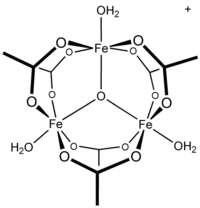Ferric acetate
 |
|
 |
|
| Names | |
|---|---|
|
IUPAC name
iron(III) acetate
|
|
| Other names
basic iron(III) acetate , iron(III) oxyacetate, iron(III) Acetate
|
|
| Identifiers | |
|
3D model (JSmol)
|
|
| ChemSpider | |
| ECHA InfoCard | 100.030.838 |
|
PubChem CID
|
|
| UNII | |
|
|
|
|
| Properties | |
| C14H27Fe3O18 | |
| Molar mass | 650.9 g/mol |
| Appearance | brownish-red amorphous powder |
| Solubility | soluble in ethanol |
|
Except where otherwise noted, data are given for materials in their standard state (at 25 °C [77 °F], 100 kPa).
|
|
| Infobox references | |
Ferric acetate is the coordination compound more commonly known as "basic iron acetate". With the formula [Fe3O(OAc)6(H2O)3]OAc (OAc− is CH3CO2−), it is a salt, composed of the cation [Fe3(μ3-O)(OAc)6(H2O)3]+ and an acetate anion. The formation of the red-brown complex has long been used as a test for ferric ions.
Basic iron acetate forms on treating aqueous solutions of iron(III) sources with acetate salts. Solid iron may be mixed with hydrogen peroxide to form iron(II and/or III) hydroxide, which can then react with vinegar/acetic acid or acetate salts to form iron(III) acetate.
Early work showed that it is trinuclear. The Fe centres are equivalent, each being octahedral, being bound to six oxygen ligands, including a triply bridging oxide at the center of the equilateral triangle. The compound was an early example of a molecular compound of iron that features an oxide ligand. Ignoring its 24 hydrogen centres, the cation has D3hsymmetry.
The terminal aqua ligands on the trimetallic framework can be substituted with other ligands, such as pyridine and dimethylformamide. Many different salts are known by exchanging the anion, e.g. [Fe3(μ3-O)(OAc)6(H2O)3]Cl. Reduction of the cation affords the neutral mixed-valence derivative that contains one ferrous and two ferric centers. Mixed metal species are known such as [Fe2CoO(OAc)6(H2O)3].
Chromium(III), ruthenium(III), vanadium(III), and rhodium(III) form analogous compounds. Iron(III) acetate (lacking the oxo ligand) has been claimed as a red coloured compound from the reaction of silver acetate and iron(III) chloride.
Materials prepared by heating iron, acetic acid, and air, loosely described as basic iron acetates, are used as dyes and mordants.
...
Wikipedia
